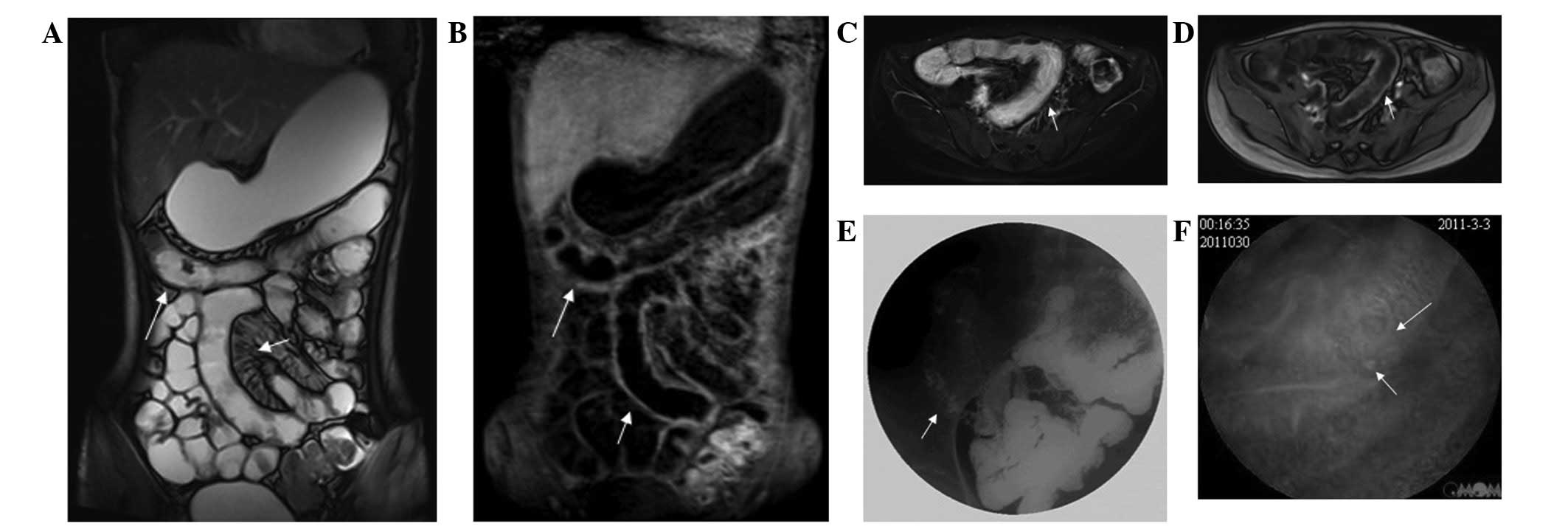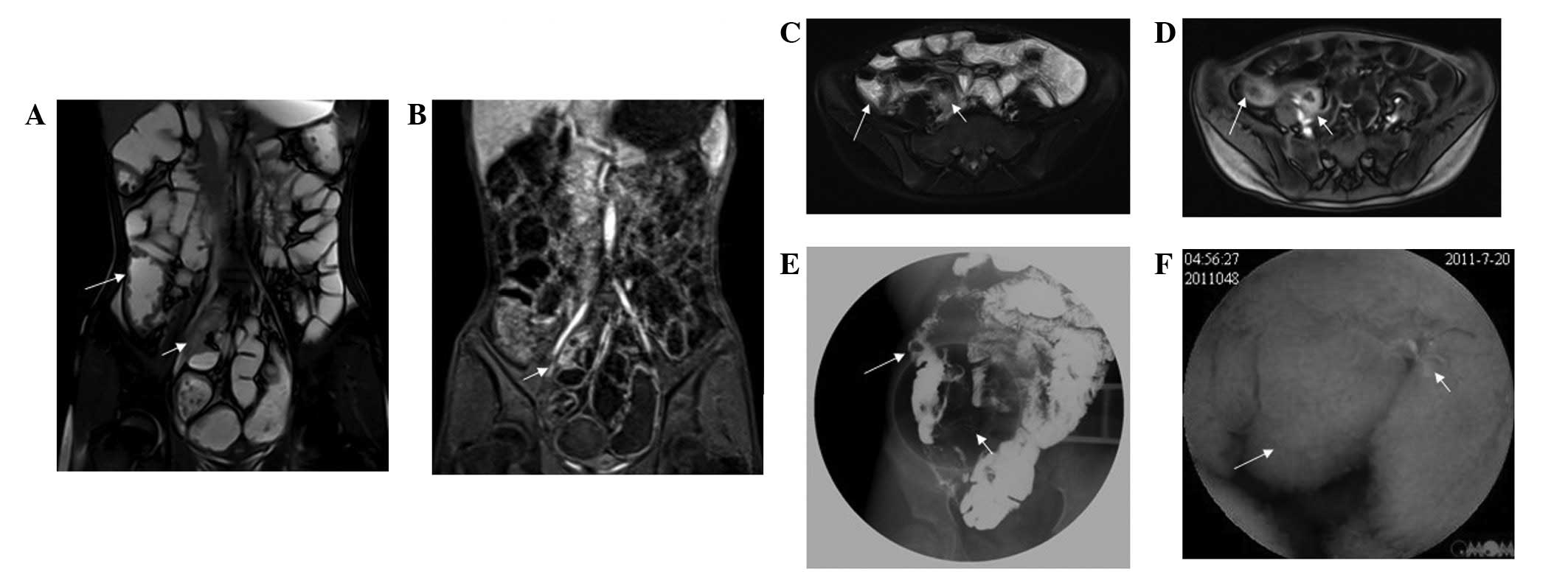|
1.
|
Masselli G, Casciani E, Polettini E and
Gualdi G: Comparison of MR enteroclysis with MR enterography and
conventional enteroclysis in patients with Crohn’s disease. Eur
Radiol. 18:438–447. 2008.PubMed/NCBI
|
|
2.
|
Sinha S, Verma R, Verma S and Rajesh A: MR
enterography of Crohn disease: part 2, imaging and pathologic
findings. AJR Am J Roentgenol. 197:80–85. 2011. View Article : Google Scholar : PubMed/NCBI
|
|
3.
|
Amzallag-Bellenger E, Oudjit A, Ruiz A,
Cadiot G, Soyer PA and Hoeffel CC: Effectiveness of MR enterography
for the assessment of small-bowel diseases beyond Crohn disease.
Radiographics. 32:1423–1444. 2012. View Article : Google Scholar : PubMed/NCBI
|
|
4.
|
Gralnek IM, Ching JY, Maza I, et al:
Capsule endoscopy in acute upper gastrointestinal hemorrhage: a
prospective cohort study. Endoscopy. 45:12–19. 2013.PubMed/NCBI
|
|
5.
|
Schwartz GD and Barkin JS: Small-bowel
tumors detected by wireless capsule endoscopy. Dig Dis Sci.
52:1026–1030. 2007. View Article : Google Scholar : PubMed/NCBI
|
|
6.
|
Chong AK, Taylor A, Miller A, et al:
Capsule endoscopy vs. push enteroscopy and enteroclysis in
suspected small-bowel Crohn’s disease. Gastrointest Endosc.
61:255–261. 2005.PubMed/NCBI
|
|
7.
|
Masselli G, Polettini E, Casciani E, et
al: Small-bowel neoplasms: prospective evaluation of MR
enteroclysis. Radiology. 251:743–750. 2009. View Article : Google Scholar : PubMed/NCBI
|
|
8.
|
Huprich JE, Fletcher JG, Fidler JL, et al:
Prospective blinded comparison of wireless capsule endoscopy and
multiphase CT enterography in obscure gastrointestinal bleeding.
Radiology. 260:744–751. 2011. View Article : Google Scholar : PubMed/NCBI
|
|
9.
|
Heo HM, Park CH, Lim JS, et al: The role
of capsule endoscopy after negative CT enterography in patients
with obscure gastrointestinal bleeding. Eur Radiol. 22:1159–1166.
2012. View Article : Google Scholar : PubMed/NCBI
|
|
10.
|
Belsey J, Crosta C, Epstein O, Fischbach
W, Layer P, Parente F and Halphen M: Meta-analysis: efficacy of
small bowel preparation for small bowel video capsule endoscopy.
Curr Med Res Opin. 28:1883–1890. 2012. View Article : Google Scholar : PubMed/NCBI
|
|
11.
|
Albert JG, Martiny F, Krummenerl A, et al:
Diagnosis of small bowel Crohn’s disease: a prospective comparison
of capsule endoscopy with magnetic resonance imaging and
fluoroscopic enteroclysis. Gut. 54:1721–1727. 2005.
|
|
12.
|
Sharma P: Advances in small bowel imaging
- capsule endoscopy. J Assoc Physicians India. 60:38–41.
2012.PubMed/NCBI
|
|
13.
|
Masselli G and Gualdi G: MR imaging of the
small bowel. Radiology. 264:333–348. 2012. View Article : Google Scholar : PubMed/NCBI
|
|
14.
|
Matsumura T, Arai M, Sato T, et al:
Efficacy of computed image modification of capsule endoscopy in
patients with obscure gastrointestinal bleeding. World J
Gastrointest Endosc. 4:421–428. 2012. View Article : Google Scholar : PubMed/NCBI
|
|
15.
|
Yamamoto H and Kita H: Enteroscopy. J
Gastroenterol. 40:555–562. 2009. View Article : Google Scholar
|
|
16.
|
Fidler JL, Guimaraes L and Einstein DM: MR
imaging of the small bowel. Radiographics. 29:1811–1825. 2009.
View Article : Google Scholar : PubMed/NCBI
|
|
17.
|
Absah I, Bruining DH, Matsumoto JM,
Weisbrod AJ, Fletcher JG, Fidler JL and Faubion WA Jr: MR
enterography in pediatric inflammatory bowel disease: retrospective
assessment of patient tolerance, image quality, and initial
performance estimates. AJR Am J Roentgenol. 199:367–375. 2012.
View Article : Google Scholar
|
|
18.
|
Siddiki HA, Fidler JL, Fletcher JG, et al:
Prospective comparison of state-of-the-art MR and CT enterography
in small bowel Crohn’s disease. AJR Am J Roentgenol. 193:113–121.
2009.PubMed/NCBI
|
|
19.
|
Paolantonio P, Ferrari R, Vecchietti F,
Cucchiara S and Laghi A: Current status of MR imaging in the
evaluation of IBD in a pediatric population of patients. Eur J
Radiol. 69:418–424. 2009. View Article : Google Scholar : PubMed/NCBI
|
|
20.
|
Malagò R, D’Onofrio M, Mantovani W, et al:
Contrast-enhanced ultrasonography (CUES) vs. MRI of the small bowel
in the evaluation of Crohn’s disease activity. Radiol Med.
117:268–281. 2012.PubMed/NCBI
|
|
21.
|
Katsinelos P, Kountouras J,
Chatzimavroudis G, Zavos C, Pilpilidis I, Fasoulas K and
Paroutoglou G: Wireless capsule endoscopy in detecting
small-intestinal polyps in familial adenomatous polyposis. World J
Gastroenterol. 15:6075–6079. 2009. View Article : Google Scholar : PubMed/NCBI
|
|
22.
|
Fidler J: MR imaging of the small bowel.
Radiol Clin North Am. 45:317–331. 2007. View Article : Google Scholar : PubMed/NCBI
|
|
23.
|
Hansmann J and Eichholz J: Radiological
diagnostics of the small bowel. Radiologe. 52:849–866. 2012.(In
German).
|
|
24.
|
Essary B, Kim J, Anupindi S, Katz JA and
Nimkin K: Pelvic MRI in children with Crohn’s disease and suspected
perianal involvement. Pediatr Radiol. 37:201–208. 2007.
|
|
25.
|
Triester SL, Leighton JA, Leontiadis GI,
et al: A meta-analysis of the yield of capsule endoscopy compared
to other diagnostic modalities in patients with non-stricturing
small bowel Crohn’s disease. Am J Gastroenterol. 102:954–964.
2006.PubMed/NCBI
|
|
26.
|
Kovanlikaya A, Watson E, Hayward J, et al:
Magnetic resonance enterography and wireless capsule endoscopy in
the evaluation of patients with inflammatory bowel disease. Clin
Imaging. 37:77–82. 2013. View Article : Google Scholar : PubMed/NCBI
|
|
27.
|
Marmo R, Rotondano G, Piscopo R, Bianco
MA, Siani A, Catalano O and Cipolletta L: Capsule endoscopy versus
enteroclysis in the detection of small bowel involvement in Crohn’s
disease: a prospective trial. Clin Gastroenterol Hepatol.
3:772–776. 2005.
|













